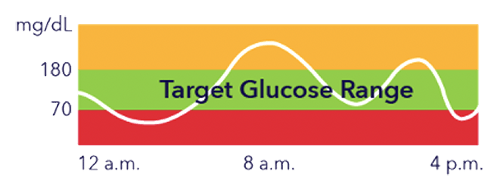Time in Range
Time in Range (TIR) is the percentage of time the blood sugar levels stay within a predetermined range for people with diabetes. The standard target glucose range is 70–180 mg/dL.1 TIR provides a more comprehensive picture of blood sugar over a period of time.
It is recommended to maintain a blood glucose, or glycemic, range of 70mg/dL (low) -180 mg/dL (high) at least 70% of time.1,3
The goal with diabetes management is to increase time spent in this target range and to minimize high and low sugar levels. Doing this can reduce the risk of both immediate and long-term health complications.


Thinking beyond A1C
A1C is an average that does not capture many important variables, including time spent high or low.
A1C versus Time in Range
A1C is the average of a person’s blood sugars over the past ninety days. The American Diabetes Association recommends that adults with diabetes should have an A1C less than 7%. This translates to an average blood sugar of 154 mg/dL.3
"What is your A1C?"
"Are you happy with your A1C?"
People living with diabetes are often faced with these questions. A1C is an average and does not give the full picture. It does not capture many important variables. It also masks the occurrence and frequency of dangerous highs and lows.
TIR provides additional insights beyond A1C. TIR provides visibility into how much time a person spends in high and low glucose levels throughout the day. It identifies day-to-day changes in blood sugar and helps people see how much time they’re spending in that healthy, feel-good range. People with similar A1C’s, might have very different blood glucose levels.


Time in Range and the MiniMed™ 780G system
Real-world results showed patients achieved up to 80% TIR with recommended settings, without increasing lows.*,4
Why is Time in Range important?
Managing blood sugar by focusing on the time spent “in range” versus the overall average can improve quality of life because it can help reduce time spent worrying. Unpredictable glucose levels have a significant negative impact on daily life for 40% of people using multiple daily injections (MDI) to manage their diabetes.5
Time in Range goals
In 2019, an international panel of clinicians, researchers, and people with diabetes met and established these goals.7
- Greater than 70% of time should be spent between 70 mg/dL and 180 mg/dL
- Less than 25% of time should be spent higher than 180 mg/dL
- Less than 4% of time should be spent below 70 mg/dL
- Less than 1% of time should be spent below 54 mg/dL
This gives people living with diabetes and healthcare professionals a tool to measure what diabetes management looks like and a target to strive for. Ideal TIR can vary from one person to another depending on factors such as medication, diabetes type, age, and health.

Looking for more tips? Join the list
Additional support
We are committed to providing #ExtraordinaryExperiences and are here to assist you with the support you may need–every step of the way.
References
* Recommended settings in adults: SmartGuard™ target: 100 mg/dL, 2 hr AIT, ages <=15: Start at SmartGuard™ target: 110mg/Dl and reduce to 100 mg/Dl if no hypos, 2 hr AIT
1. CGM & Time in Range. American Diabetes Association. Available at: https://diabetes.org/tools-support/devices-technology/cgm-time-in-range. Accessed June 19, 2023.
2. Time In Range – https://diatribe.org/time-range. Accessed 9 February 2021.
3. American Diabetes Association (2019). Standards of medical care in diabetes—2019. Diabetes Care, 42(Suppl 1): S61-S70.
4. Choudhary P. et al, Lancet Diabetes Endocrinol. 2022; https://doi.org/10.1016/ S2213-8587(22)00245-5
5. Kaufman FR, Gibson LC, Halvorson M, et al. A pilot study of the continuous glucose monitoring system. Diabetes Care. 2001;24(12):2030-2034.
6. Nicolucci A, Kovacs Burns K, et al. Research: Educational and Psychological Issues Diabetes Attitudes, Wishes and Needs second study. Diabet Med. 2013;30:767–777.
7. Tadej Battelino, Thomas Danne, Richard M. Bergenstal et al. Clinical Targets for Continuous Glucose Monitoring Data Interpretation: Recommendations from the International Consensus on Time-in-Range” in Diabetes Care 2019 Aug; 42(8): 1593-1603.



